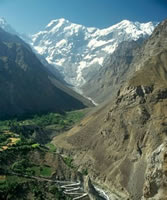TAXILA

 Taxila is an important archaeological site in the Punjab province of Pakistan. It dates back to the Ancient Indian period and contains the ruins of the Gandhāran city of Takshashila (also Takkasila or Taxila) an important Vedic/Hindu and Buddhist centre of learning from the 6th century BCE to the 5th century CE. In 1980, Taxila was declared a UNESCO World Heritage Site with multiple locations.
Taxila is an important archaeological site in the Punjab province of Pakistan. It dates back to the Ancient Indian period and contains the ruins of the Gandhāran city of Takshashila (also Takkasila or Taxila) an important Vedic/Hindu and Buddhist centre of learning from the 6th century BCE to the 5th century CE. In 1980, Taxila was declared a UNESCO World Heritage Site with multiple locations.Historically, Taxila lay at the crossroads of three major trade routes: the royal highway from the north-western route through Bactria, and (Peshawar); and the route from Kashmir and Central Asia, via Śrinigar, Mansehra, and the Haripur valley across the Khunjerab pass to the Silk Road.
Taxila is situated about 32 km to the north-west of Islamabad Capital Territory—and Rawalpindi in Punjab—just off the Grand Trunk Road. Its elevation above the sea-level is 549 meters.
Present day Taxila is one of the seven Tehsils (sub-district) of Rawalpindi District. It is spread over an undulating land in the periphery of the Pothohar Plateau of the Punjab. Situated just outside the capital Islamabad's territory and communicating with it through Tarnol pass of Margalla Hills.
Taxila is a mix of posh urban and rustic rural environs. Urban residential areas are in the form of small neat and clean colonies populated by the workers of heavy industries, educational institutes and hospitals that are located in the area.
Nicholson's obelisk, a monument of British colonial era situated at the Grand Trunk road welcomes the travelers coming from Rawalpindi/Islamabad into Taxila. The monument was built by the British to pay tribute to Brigadier John Nicholson (1822-1857) an officer of the British Army who died in India during the war of independence of 1857.
The industries include heavy machine factories and industrial complex, ordnance factories of Wah Cantt and cement factory. Heavy Industries Taxila is also based here. Small, cottage and household industries include stoneware, pottery and footwear. People try to relate the present day stoneware craft to the tradition of sculpture making that existed here before the advent of Islam.
In addition to the ruins of Gandhara civilization and ancient Buddhist/Hindu culture, relics of Mughal gardens and vestiges of historical Grand Trunk Road, which was built by Emperor Sher Shah Suri in 15th-16th centuries, are also found in Taxila region.
Taxila Museum, dedicated mainly to the remains of Gandhara civilization, is also worth visiting. A hotel of the tourism department offers reasonably good services and hospitality to the tourists.
Taxila has many educational institutes including University of Engineering and Technology(UET).



Comments
Post a Comment